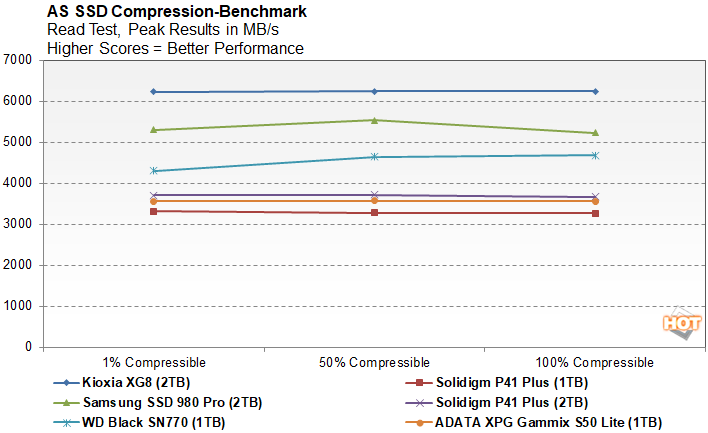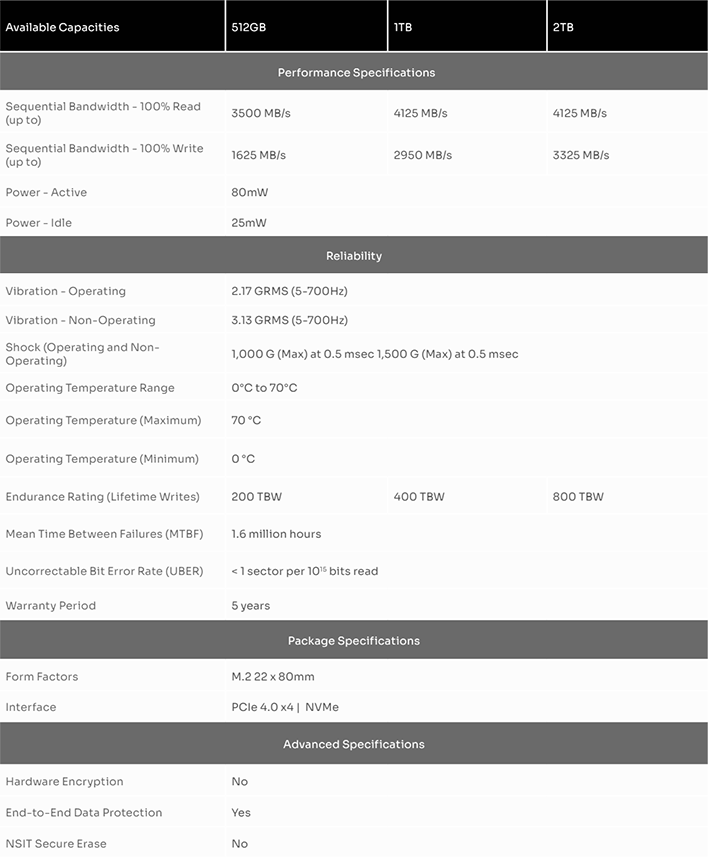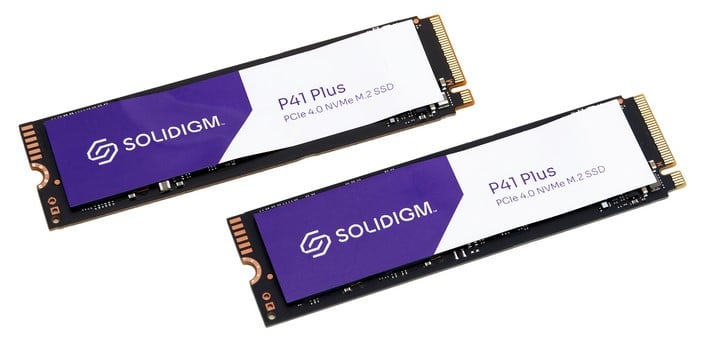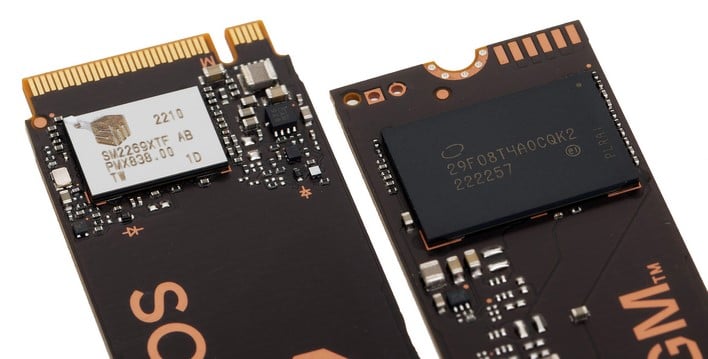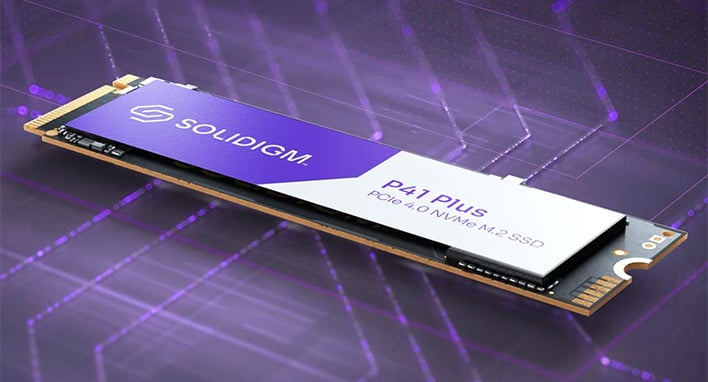Solidigm P41 Plus SSD Review: Strong PCIe 4 Storage Value
Solidigm P41 Plus: Affordable, High-Capacity NVMe PC Storage
| Solidigm P41 Plus: Starting At $82.99 The Solidigm P41 Plus is an affordable, DRAM-less PCIe 4 Solid State Drive, tuned for low queue depths and mainstream computing workloads. It offers good throughput at very attractive price points.
|
|||

|

|
||
Solidigm has seemingly not missed a beat since the company was recently spun out of Intel. Now under the ownership of SK hynix, Solidigm has continued producing high quality and high performance solid state drives for a variety of markets, spanning from the consumer space to the data center. These products do not simply appear overnight, though, so some of Intel's DNA is still present in products like the P41 Plus SSD we have up for review today.
Case in point, the P41 Plus is built using 144-layer 3D QLC NAND technology developed at Intel, but for all intents and purposes should be treated as homegrown from Solidigm. The P41 Plus is like a DRAM-less version of its predecessor, the Intel SSD 670p, using the same NAND paired with a newer controller. Given this pedigree, we can expect the drive to be a strong performer in its competitive range while retaining respectable endurance and reliability. Let's dig into the particulars and unpack this new PCIe 4.0 NVMe SSD for a deep-dive performance evaluation.
Solidigm P41 Plus Specifications And Features
The Solidigm P41 Plus is well-equipped for its mainstream, value-oriented positioning. It is rated for sequential read speeds of 4125 MB/s and write speeds of 3325 MB/s over the PCIe 4.0 interface in its highest capacity form (2TB). The 512GB version is notably slower with 3500 MB/s read and 1625 MB/s write speed ratings, but this is typical for lower capacity drives in a product stack. Performance tends to scale with added capacity as transfers can parallelize across more NAND chips and controller channels.Sequential speeds are only part of the performance picture. Random transfer ratings are every bit as important for the kinds of operations that keep a PC going throughout day-to-day tasks. On this front, the P41 Plus is rated for random reads up to 390K IOPS and random writes up to 540K IOPS, in its 2TB capacity. The 1TB drive drops random reads down to 225K IOPS but random writes remain comparatively high at 520K IOPS.
While the 1TB and 2TB models outlay performance that is solidly within PCIe 4.0 territory, neither is close to saturating the interface. If raw speed is more important than value, consumers are likely better served by the higher end Solidigm P44 Pro models. The P41 Plus drives forego a DRAM cache which is typically used to accelerate smaller transfers, and is found in both the Solidigm P44 Pro (review coming soon) and Intel 670p. Instead, it leverages a pseudo SLC (pSLC) cache. SLC NAND is not as fast as DRAM, but still out-performs QLC by big margin, especially with respect to write operations. It is less dense and more expensive to produce than QLC though, so pSLC caches are typically kept quite small.
In any case, the P41 Plus drives carry respectable reliability metrics. The drives all come with a 5 year warranty period, with mean time between failures (MTBF) clocking 1.6 million hours of operation, or about 182 years. With endurance ratings of 200, 400, and 800 TBW for 512GB, 1TB, and 2TB capacities, respectively, Solidigm is confident that these drives will go the distance. Those ratings correspond to about 400 total drive writes of each given capacity, and few of us are completing the equivalent of even a single drive write each month.
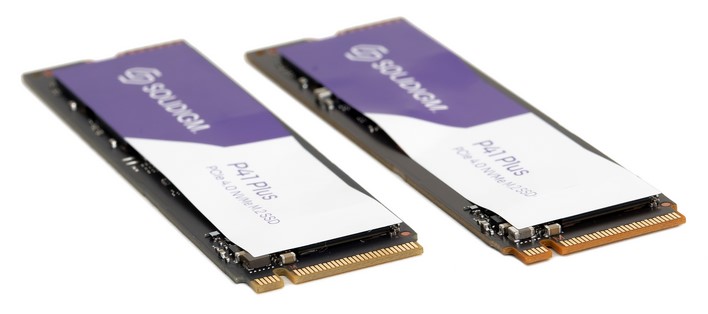
Solidigm P41 Plus SSD Benchmarks
Under each test condition, the SSDs showcased here were installed as secondary volumes in our testbed, with a separate drive used for the OS and benchmark installations. Our testbed's motherboard was updated with the latest BIOS available at the time of publication and Windows 11 was fully updated. Windows firewall, automatic updates, and screen savers were all disabled before testing and Focus Assist was enabled to prevent any interruptions.
In all test runs, we rebooted the system, ensured all temp and prefetch data was purged, and waited several minutes for drive activity to settle and for the system to reach an idle state before invoking a test. All of the drives here have also been updated to their latest firmware as of press time. Where applicable, we would also typically use any proprietary NVMe drivers available from a given manufacturer, but all of the drives featured here used the Microsoft driver included with Windows 11.
HotHardware's Test System:
| Processor: AMD Ryzen 9 7950X Motherboard: Asus ROG CrossHair X670E Hero Video Card: GeForce RTX 3080 Memory: 32GB G.SKILL DDR5-5200 Storage: ADATA XPG GAMMIX S70 Blade (OS Drive) ADATA XPG GAMMIX S50 Lite (1TB) Kioxia XG8 (2TB) Samsung 980 Pro (2TB) Solidigm P41 Plus (2TB) Solidigm P41 Plus (1TB) WD Black SN770 (1TB) |
OS: Windows 11 Pro x64 Chipset Drivers: AMD v3.10.22.706 Benchmarks: IOMeter 1.1 HD Tune v5.75 ATTO v4.01.01f AS SSD SiSoftware SANDRA CrystalDiskMark v8.0.4 x64 Final Fantasy XIV: Endwalker PCMark 10 Quick Storage Bench 3DMark Storage Tests |
IOMeter Benchmarks
IOMeter is a well-respected industry standard benchmark. However, despite our results with IOMeter scaling as expected, it is debatable as to whether or not certain access patterns actually provide a valid example of real-world performance. The access patterns we tested may not reflect your particular workloads, for example. That said, we do think IOMeter is a reliable gauge for relative throughput, latency, and bandwidth with a given storage solution. In addition, there are certain highly-strenuous workloads you can place on a drive with IOMeter, that you can't with most other storage benchmark tools.In the following tables, we're showing two sets of access patterns; a custom Workstation pattern, with an 8K transfer size, consisting of 80% reads (20% writes) and 80% random (20% sequential) access and a 4K access pattern with a 4K transfer size, comprised of 67% reads (33% writes) and 100% random access. Queue depths from 1 to 16 were tested...
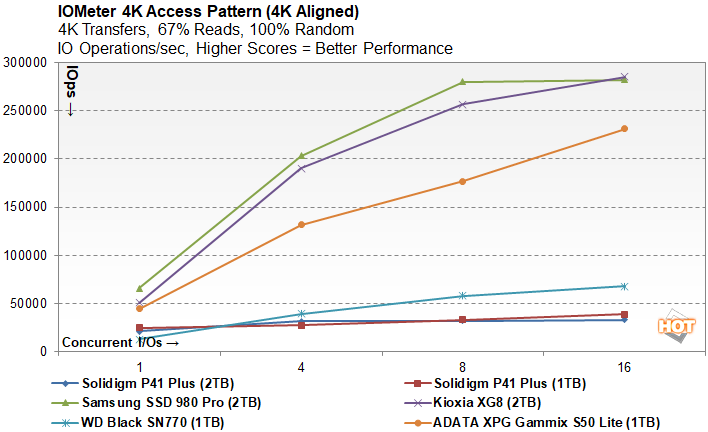
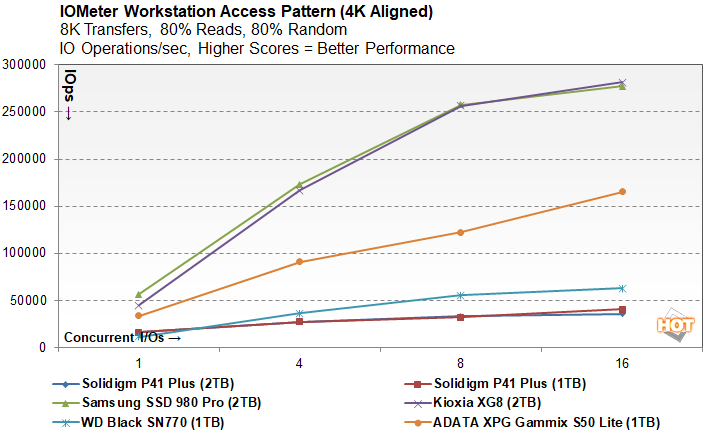
At 4K and 8K transfers, the Solidigm P41 Plus drives perform very similarly, though both trail the competition by a pretty wide margin. Much of this is due to the lack of a DRAM cache, but the WD Black SN770 is similarly DRAM-less and puts up a slightly stronger showing except at the lowest queue depth.
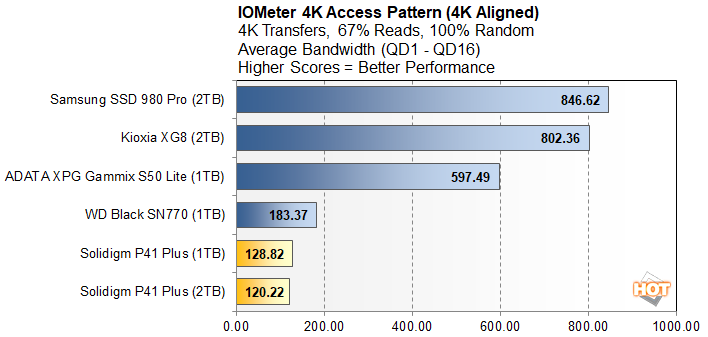

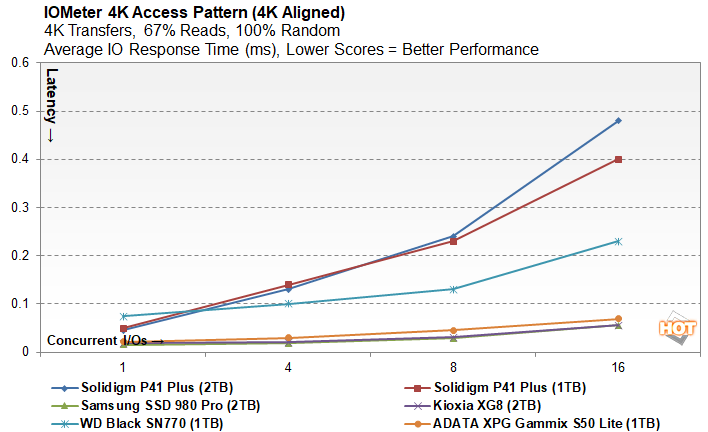

Our latency results show the correlating higher latency toll on the P41 Plus drives. The 1TB variant is marginally better than the 2TB model at high queue depths, but latency is arguably less impactful as queue depth increases. With a queue depth of 1, these drive are not significantly different from the rest of the field, which bodes well for system responsiveness.
SiSoft SANDRA 2021

The ADATA XPG Gammix S50 Lite was stronger performer in IOMeter's 4K and 8K transfers, but finds itself below the Solidigm P41 Plus in sequentials here for all but average writes. We can see the 2TB P41 Plus' stronger write performance here, while read speeds are nearly indistinguishable from the 1TB model.
ATTO Disk Benchmark
ATTO is another "quick and dirty" type of disk benchmark that measures transfer speeds across a specific volume length. It measures raw transfer rates for both reads and writes and graphs them out in an easily interpreted chart. We chose .5KB through 64MB transfer sizes and a queue depth of 6 over a total max volume length of 256MB. ATTO's workloads are sequential in nature and measure raw bandwidth, rather than I/O response time, access latency, etc.
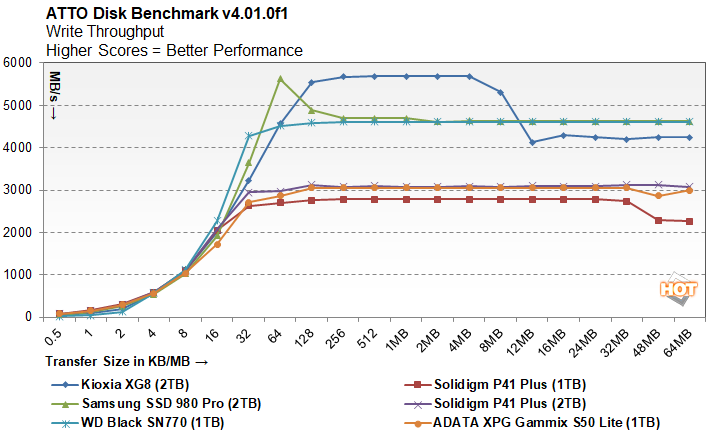

With ATTO, we see the Solidigm P41 Plus hit its stride at around 32KB writes and 128KB reads. Overall performance is again similar to the ADATA XPG Gammix S50 Lite, with the three results all falling into the same midrange performance ballpark.

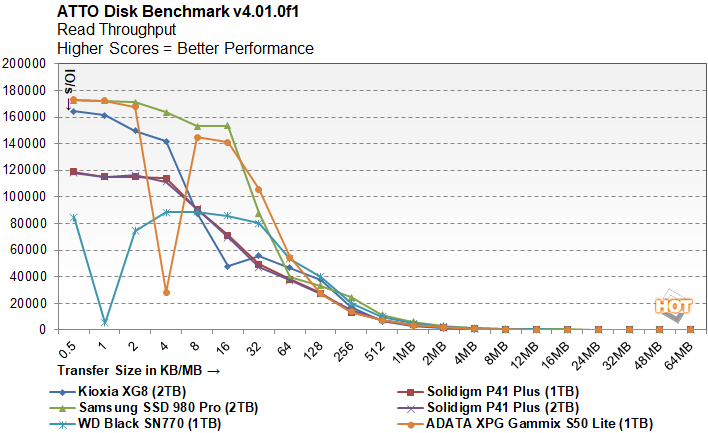
IO performance is virtually identical for both reads and writes between the P41 Plus models. Write speeds lead the pack at tiny transfer sizes, but ultimately lands at the bottom of the curve upon reaching 32KB. Read speeds fall more in the middle, but we will note that these drives have some of the most consistently smooth performance scaling across the range, with no real outliers like we see with the ADATA and WD drives in particular.
AS SSD Compression Benchmark
Next up we ran the Compression Benchmark built-into AS SSD, an SSD specific benchmark being developed by Alex Intelligent Software. This test is interesting because it uses a mix of compressible and non-compressible data and outputs both Read and Write throughput of the drive. We only graphed a small fraction of the data (1% compressible, 50% compressible, and 100% compressible), but the trend is representative of the benchmark’s complete results.
